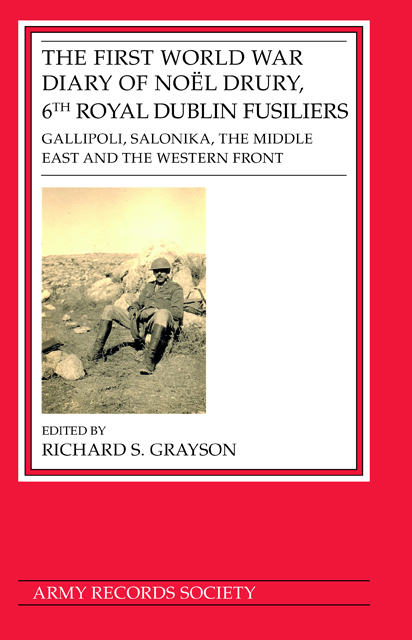 First World War Diary of Noël Drury, 6th Royal Dublin Fusiliers
First World War Diary of Noël Drury, 6th Royal Dublin Fusiliers Book contents
- Frontmatter
- Miscellaneous Frontmatter
- Contents
- List of Illustrations
- Acknowledgements
- List of Abbreviations
- Introduction
- 1 Volunteering and Training, September 1914–July 1915
- 2 The Voyage to the Dardanelles, July–August 1915
- 3 Gallipoli: Landing at Suvla Bay and the Next Ten Days, 7–17 August 1915
- 4 Gallipoli: Digging In, 18 August–October
- 5 The Serbian Front and the Battle of Kosturino, October–December 1915
- 6 The Salonika Front and Hospital, December 1915–September 1917
- 7 Egypt and Palestine, September–December 1917
- 8 Defending Jerusalem and the Battle of Tell ‘Asur, December 1917–July 1918
- 9 France, July–11 November 1918
- 10 Armistice, 12 November 1918– 11 March 1919
- Appendix 1 6th Royal Dublin Fusiliers leaving home for service overseas, 10 July 1915
- Appendix 2 The Effects of the Gallipoli Campaign on the 6th Royal Dublin Fusiliers
- Appendix 3 Officers of the 6th Royal Dublin Fusiliers at Hastière-sur-Meuse, Nov 1918
- Biographies
- Bibliography
- Index
6 - The Salonika Front and Hospital, December 1915–September 1917
Published online by Cambridge University Press: 14 June 2023
- Frontmatter
- Miscellaneous Frontmatter
- Contents
- List of Illustrations
- Acknowledgements
- List of Abbreviations
- Introduction
- 1 Volunteering and Training, September 1914–July 1915
- 2 The Voyage to the Dardanelles, July–August 1915
- 3 Gallipoli: Landing at Suvla Bay and the Next Ten Days, 7–17 August 1915
- 4 Gallipoli: Digging In, 18 August–October
- 5 The Serbian Front and the Battle of Kosturino, October–December 1915
- 6 The Salonika Front and Hospital, December 1915–September 1917
- 7 Egypt and Palestine, September–December 1917
- 8 Defending Jerusalem and the Battle of Tell ‘Asur, December 1917–July 1918
- 9 France, July–11 November 1918
- 10 Armistice, 12 November 1918– 11 March 1919
- Appendix 1 6th Royal Dublin Fusiliers leaving home for service overseas, 10 July 1915
- Appendix 2 The Effects of the Gallipoli Campaign on the 6th Royal Dublin Fusiliers
- Appendix 3 Officers of the 6th Royal Dublin Fusiliers at Hastière-sur-Meuse, Nov 1918
- Biographies
- Bibliography
- Index
Summary
Having withdrawn to Salonika, the British and French soon began to extend their defensive positions beyond the city. They created an area which became known as ‘The Birdcage’, extending about 15 miles west, 10 miles north and around 40 miles east to the coast of the Gulf of Rendina. This meant that after arriving at Salonika in mid-December 1915, the next six months saw the 6th Royal Dublin Fusiliers located in a number of places just outside the city. Initially, they recovered from their time at Gallipoli and took stock of their equipment. Little more than a week after their arrival they began to work on digging and building the Birdcage.
By mid-January Drury believed that ‘The defence works are getting immensely strong and I don't think any Balkan army, as usually equipped, could get through.’ He described how the placing of wire would force attacking troops to bunch together in gaps covered by machine gun crossfire. Work was hard, but there were opportunities for tourism and Drury wrote many accounts of his outings. In one, he described the Turkish bazaar in old Salonika. The amount of material gathered by officers and men suggested that many had patronised local traders. There were also battalion exercises and sports competitions. In late April, ‘We got the most astounding news […] that a rebellion had broken out in Ireland.’ Drury feared, ‘I don't know how we will be able to hold our heads up here as we are sure to be looked upon with suspicion.’ However, such fears appear to have been ill-founded as there were no signs in later diary entries of them being realised. Drury's duties within the battalion changed in early May as he lost his Adjutant responsibility and became Assistant Adjutant with, again, a role in signals. All of this time around Salonika was calm, with the nearest sighting of enemy forces being a Zeppelin which was shot down, although martial law was imposed on the town in early June after the Greeks had withdrawn their garrison at the entrance to the Struma Valley. This raised fears that Greece might capitulate to the Bulgarians and a standoff ensued between British/French and Greek forces, after which Greece eventually agreed to demobilise its forces.
- Type
- Chapter
- Information
- First World War Diary of Noël Drury, 6th Royal Dublin FusiliersGallipoli, Salonika, the Middle East and the Western Front, pp. 144 - 177Publisher: Boydell & BrewerPrint publication year: 2022


